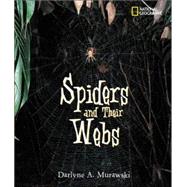Spiders and Their Webs
, by MURAWSKI, DARLYNE A.- ISBN: 9780792269793 | 0792269799
- Cover: Hardcover
- Copyright: 10/1/2004
In Spiders and Their Webs biologist-photographer Darlyne Murawski shares her fascination with web-spinning spiders with young readers. They will learn that not all spiders weave webs, but those that do not only create an incredible variety of designs but also have different ways of using their webs to catch their prey. Readers will meet some familiar spiders, such as the argiope and the comb-footed spider, that they might find in their backyards or in their basements. But they will also meet spiders that live in tropical rain forests, underwater, and in tunnels underground. Readers will discover that some spiders make patterns in their webs that mimic flowers. When a bee comes too near, instead of getting a sip of nectar, it finds itself trapped in a sticky mess. The ogre-faced spider hangs from a silk thread and holds its web between its front feet while it waits for a caterpillar or some other prey to come along. Then it traps its victim by casting its web on top of it like a net. The Hawaiian happy-faced spider uses a sticky strand of silk like a lasso to rope a meal and bring it back to its web. The European water spider gathers bubbles of air then dives underwater and releases the air into its web. Eventually the web balloons up to look like a diving bell. The spider swims out to catch food with its feet and then drags it inside the bubble web to eat. Readers will learn that not all web masters are solitary hunters. Some live in colonies of hundreds of thousands of tiny spiders and make webs that are big enough to cover a garbage truck! By working together they can catch prey that is many times larger than they are. The author's easy-to-read text explains all the action captured in her eye-catching, full-color photographs of the spiders and their webs. The book is enhanced by fact boxes that list scientific names, common names, food, habitat, and body size, playful illustrations that highlight interesting behavior, and fun trivia. Readers also get some insight into other ways spiders use their silk. The author shares experiences from the field, such as how she makes spider webs visible to photograph them (kids can do it too). Also included are a glossary of terms, a list of Web sites, and books for further reading.







